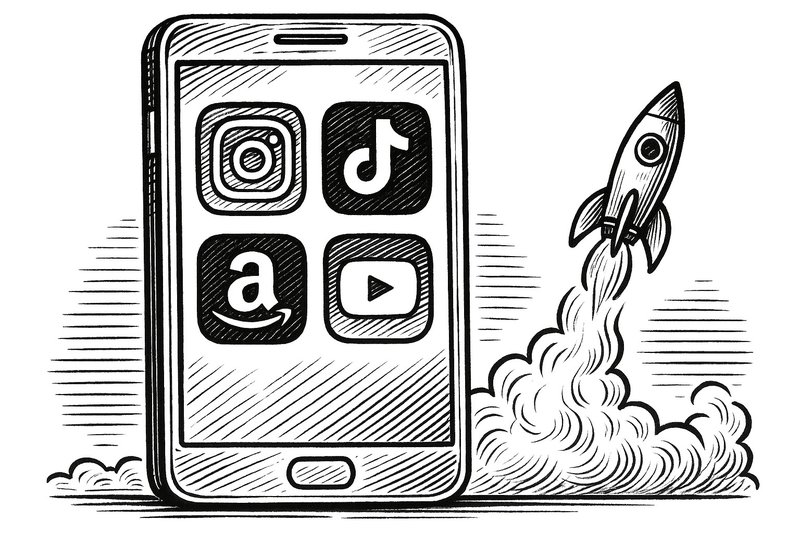
Mobile marketing strategy isn't a "nice to have" anymore—it's how customers live, choose, and buy. Without prioritizing mobile first, businesses risk falling behind. Where should one start? Before investing in flashy apps or ads, a focused mobile plan is essential. This guide outlines the steps to drive results, not regret.
Key Takeaways:
- By 2026, over 80% of shoppers will buy on mobile; mobile strategy is a must.
- Set SMART goals (e.g., grow SMS signups by 25% in 3 months).
- Legal compliance requires clear user consent and opt-out options (GDPR, TCPA).
- Best mobile ad platforms: Meta Ads, Google Ads, GroundTruth.
- Top user acquisition channels: search ads, social media, referrals.
- Key ASO elements: name, icon, description, keywords, screenshots, and reviews.
- Boost engagement with loyalty rewards, tooltips, real-time features, and social sharing.
- Monetize apps through ads, in-app purchases, subscriptions, and freemium models.
- Best social channels for app promotion: Instagram, TikTok, YouTube.
- Use geofencing for local promotions; 76% of “near me” searches lead to visits.
- Track ROI using CTR, ROAS, and install retention; tools include Firebase, AppsFlyer.
- Storytelling increases emotional connection and campaign results.
Building a Strong Foundation for Your Mobile Marketing Strategy
Understanding the Importance of Mobile Marketing
Mobile marketing is crucial for reaching people on their phones, where they spend the majority of their time. With over 80% of shoppers forecasted to buy on mobile by 2026, integrating mobile-first into your marketing strategy is essential. Discover more about effective strategies by visiting our blog.
Setting Clear Goals for a Mobile-First Marketing Strategy
How to Define Goals for a Mobile Marketing Strategy
Achieving business results requires precise goal setting. Establish targets such as increasing store visits, app usage, or coupon redemptions. Use SMART goals—Specific, Measurable, Attainable, Relevant, and Time-based. For example: Grow SMS signups by 25% in 3 months. Vague goals like “get more users” aren’t effective.
Develop a mobile content strategy to align with these goals. Content should support goals, highlighting local events or in-store savings if foot traffic is the focus. Consider what users need on the go—store maps, open hours, menus, or quick deals are key.
Follow the SQuAD Method:
- Set measurable goals like app downloads or SMS opt-ins.
Enhancing Your Mobile Marketing Strategy with Privacy and User Safety
Legal and Privacy Considerations for Mobile Campaigns
Obtaining clear consent before sending mobile messages is imperative. Adhere to privacy laws such as GDPR or TCPA. Users must agree to join marketing lists with an option to opt out at any time. Non-compliance can lead to significant fines and a loss of trust.
Use this Compliance Checklist:
- Maintain consent records for each user.
- Provide clear opt-out steps.
- Ensure data storage in line with legal requirements.
- Communicate honestly—avoid misleading offers.
Trust forms the base of any campaign. Without it, strategies will falter.
Selecting Tools and Measuring Success in Mobile Marketing
Once goals and legal obligations are established, selecting the right tools is crucial. Opt for SMS and push platforms that scale easily and enable quick updates.
Key Actions to Track:
- Clicks
- Store visits
- Coupon use
- App usage
- Returning users
Effective mobile marketing is not about indiscriminate messaging—it's about understanding what works.
Think of these elements as the ground floor of your strategy. Your tools, content, and user trust create a strong base upon which anything can be built.
Effective Techniques for Promoting Your Mobile App
Where Are Users Spending Time?
Identifying where users spend their time is essential for a successful mobile marketing strategy. Today’s audiences primarily engage on social media, but not all platforms yield the same results for app promotion. Employ the SQuAD method to focus on the top three platforms: Instagram, TikTok, and YouTube. Each platform is ideal for delivering fast, visual content with a broad reach.
Platform-Specific Strategies
- Instagram: Utilize reels, stories, and sponsored posts to create dynamic content that resonates with users.
- TikTok: Emphasize viral clips and quick engagement, perfect for fun and simple apps.
- YouTube: Leverage longer reviews or how-to videos, especially for apps that solve problems or offer numerous features.
Learn more about successful social media strategies for app promotion.
Harnessing Influencer Partnerships
Influencer marketing can significantly boost your app's visibility and trustworthiness. Opt for smaller influencers (under 100,000 followers) who exude authenticity. Their lifestyle should align with your app, providing a relatable context for their audience. This approach generally delivers better results than traditional ads.
For instance, a fitness app collaborating with Instagram health coaches increased installs and improved user retention compared to traditional advertisements.
The Role of Paid Ads in Mobile Marketing Strategy
For scalability, app-install ads on platforms like TikTok and Instagram are vital. Set specific budgets and sharp goals, creating short ads that quickly highlight the app’s value. If your app offers in-app rewards, ensure this value is communicated upfront.
The Power of Organic Content
Organic content is another facet of a robust mobile marketing strategy.
- Post-app tips, videos, updates, and support replies.
- Keep information concise and shareable.
- Solicit feedback from followers to guide app updates.
Connect these efforts with app stores to streamline the installation process—fewer clicks lead to more installations.
Attracting and Acquiring Quality Mobile App Users
Identifying High-Quality Acquisition Channels
Successful mobile app strategies begin by understanding prime acquisition channels:
- Search Ads: Effective for attracting users with predefined intent, leading to higher retention.
- Social Ads: Choose the right platform—Instagram for retail, TikTok for games. Content should be concise and focused on app utility.
- Referrals: Ensure your referral program is simple and fair, offering mutual rewards for the referrer and the friend.
Designing an Effective Referral Program
Simple and attractive referral programs thrive. Keep messages concise and place offers in popular user sections. Monitor shares and installations to expand the program’s reach continuously.
Smart Cross-Promotion Tactics
Cross-promotion involves leveraging internal tools to support user growth:
- Promote one app within others if your brand offers multiple apps.
- Utilize websites, emails, or blogs to connect users with app promotions.
- Collaborate with brand partners to trade ad space for complementary products.
Use push notifications or SMS alerts to engage users with the potential benefits of new apps.
Mobile Advertising Strategies for Scaled Performance
Selecting the Right Ad Platforms
Choosing the right platform is fundamental to an effective mobile marketing strategy. Meta Ads, Google Ads, and GroundTruth dominate in targeting and ROI.
- Google Ads: Capture users actively searching for solutions.
- Meta Ads: Target based on interests or behavior.
- GroundTruth: Utilize location-based targeting for increased local shop visits.
Budgeting and Campaign Optimization
Maintain affordability in PPC campaigns by starting small, monitoring closely, and adjusting quickly. Implement geofencing to minimize waste and maximize relevance.
- Execute A/B tests on titles, deals, and visuals.
- Ensure landing pages load swiftly within three seconds.
Crafting High-Performing Mobile Ad Campaigns
A successful campaign aligns with user interests using short headlines, clear calls to action, and immediate value propositions. Use lookalike audiences based on top users to expand reach effectively. Keep ad content engaging with formats like AR or brief 15-second videos.
Review campaigns weekly and examine user behaviors like scrolling and purchasing to refine next steps.
By combining these strategies, businesses can ensure their mobile app reaches and resonates with the right audience, maximizing both installs and retention.
How to Optimize Your App’s Presence with a Mobile Marketing Strategy
Start by helping users discover your app—this is your ASO guide.
Key Elements of Successful ASO in Mobile Marketing
- App Name and Icon: Choose a clear, searchable name that reflects your app. Design an icon that remains sharp even at small sizes.
- Short Description: Craft a compelling app summary that explains why users should download your app.
- Keywords: Integrate strong keywords in the title and description to enhance app store searchability.
Choose images that showcase your app’s features. Add small labels on screenshots for clarity, and where possible, include a short video.
Leveraging Reviews and Ratings
The Impact of Reviews on Download Rates
High ratings increase app visibility and user trust within app stores. More stars equate to more downloads, while apps with low ratings often get ignored.
Tactics for Encouraging Positive App Reviews
- Timing and Context: Request reviews after a positive user experience, ensuring it is easy and hassle-free.
- Feedback Management: Thank users for high ratings, and address any critical feedback promptly.
Paying for fake reviews is discouraged as it may lead to being flagged or demoted by app stores. Genuine reviews build real trust. Focus on honest feedback and strong visuals to elevate your app in rankings, drawing more authentic users.
Long-Term Mobile Marketing Strategy for User Engagement
Prioritize showcasing value to engage users. Understand user behavior to tailor your engagement plan effectively.
Features Enhancing In-App User Engagement
- Reward Systems: Implement points, badges, or progress indicators to encourage activity.
- User Guidance: Use helpful prompts for new users. As seen with Pagarkhata, tooltips can improve activation rates by 3.5x.
- Live Updates and Entertainment: Incorporate live updates, games, polls, or quick offers to boost repeat usage.
Retention Techniques for Prolonged User Engagement
- Habit Formation: Use nudges like push tips based on behavior.
- Time-Limited Offers: Employ mobile-only deals to achieve higher user response rates.
- Personalization: Save user preferences and suggest content based on past usage.
- Group-Based Tools: Leaderboards and shared challenges incentivize return visits.
Effective Re-Engagement Campaigns
Crafting Personalized and Timely Campaigns
For lapsed users, send a smart reminder tied to past behavior. Personal, timely messages yield better results. Include incentives if aligned with previous activities.
Targeting physical context also enhances results. For example, a deal sent when users are near a store can drive action, as demonstrated by Burger King's proximity campaign with McDonald's.
Driving Conversions with Location-Based Mobile Marketing Strategies
Explore top ways to use geotargeting and geofencing for conversions.
Effective Use of Geotargeting and Geofencing
- Proximity Promotions: Send timely offers when users are near your business or competitors.
- Event-Based Targeting: Increase engagement through event-specific promotions.
Respecting Privacy in Location-Based Marketing
- Data Privacy Compliance: Always seek permission, openly explain data use, and provide clear opt-out options, in line with GDPR and CCPA. Transparency fosters trust and enhances campaign effectiveness.
Discover practical strategies and insight into location-based marketing ideas, ensuring outreach remains useful and respectful.

The Role of Content and Storytelling in a Mobile Marketing Strategy
Why Storytelling Matters in Mobile Experiences
Storytelling within a mobile marketing strategy is critical for establishing personal connections with users. Effective stories evoke emotions, making content memorable. For instance, the "Whopper Detour" campaign by Burger King combined humor and timing to generate strong engagement and compel action.
Designing Content for Mobile-First Consumption
Creating content tailored for mobile devices requires simplicity and immediacy:
- Maintain brevity and scannability.
- Use silent videos and quick, bold visuals.
- Break complex ideas into short, impactful messages.
Content must load quickly, even on slower networks, ensuring accessibility. Explore more on crafting mobile-friendly content here.
Examples of Emotionally Resonant Mobile Campaigns
Engaging mobile campaigns inspire emotions like joy, pride, or connection:
- Nike's "You Can't Stop Us" campaign utilized fast visuals and strong messaging for widespread appeal.
- Adidas's WhatsApp initiative fostered real-time interaction, providing a simple yet impactful experience.
Even a modest budget can create a lasting impact when combined with thoughtful storytelling. Learn more about mobile storytelling here.
Tracking, Analyzing, and Improving Mobile Marketing Campaigns
Essential Metrics for Mobile Marketing Strategy Success
Key performance indicators to assess mobile marketing campaign health include:
- Click-through rate (CTR)
- Return on ad spend (ROAS)
- Time spent in the app
- Opt-out rate
- Retention rate
Precision and recall metrics provide insight into output quality.
Calculating ROI for Mobile Marketing Campaigns
To measure return on investment:
[ text{ROI} = frac{text{Gain} – text{Cost}}{text{Cost}} ]
For example, if an ad earns $2,000 with a $500 cost, ROI is 300%. Ensure actions are linked to the campaign for accuracy.
Tools for Effective Campaign Measurement
Leverage tools like Firebase, AppsFlyer, Adjust, Branch, and Mixpanel to monitor user journeys from installation to purchase. These provide insights into ad spend efficiency and user interactions.
Improving Campaigns Using Data
Enhance campaigns by:
- Addressing slow page loads
- Eliminating unnecessary steps
- Enhancing hooks through A/B testing
Refined targeting based on user engagement optimizes returns. Weekly assessments foster ongoing improvement.
Supporting Long-Term Growth and Revenue Through Mobile Marketing Strategy
Leading App Monetization Models in 2025
Consider these monetization strategies:
- In-app ads (click-based payouts)
- In-app purchases (additional content)
- Subscription models (regular access)
- Freemium offerings (base free, premium upgrades)
Select models that align with user preferences, blending strategies if necessary.
Fueling Growth with an Integrated Mobile-First Approach
With over 70% of traffic on mobile, businesses must prioritize:
- Mobile-first design: intuitive interfaces, rapid load times, compelling calls to action
- Synchronized channels: align email, SMS, and social efforts
- Geofencing: leverage location for sales conversion
A strategically timed promo can transform casual interest into measurable sales. Discover more strategies here.
Mapping and Activating the Full Mobile User Journey
Track and optimize each stage in the user journey:
- Initial contact
- Installation
- First app open
- Key user actions
- Return visits
- Referrals
Segment users into categories:
- New: provide welcome tips
- Active: offer rewards and perks
- Lapsed: deliver win-back offers
A strategic approach ensures users remain engaged and aligned with the brand's mobile marketing objectives.
Ready to Transform Your Mobile Marketing Strategy?
The path to growth runs through clear goals, tested tools, and trust. With your mobile strategy mapped out, it's time to turn your plans into action. Set precise targets, leverage proven tools, and build trust with your audience to ensure your business thrives in the mobile-first world. Don't let your competitors get ahead—capitalize on the vast opportunities mobile marketing offers today. For tailored strategies and expert support, reach out to iProv and let us help you drive meaningful growth. Your success is just a step away!
